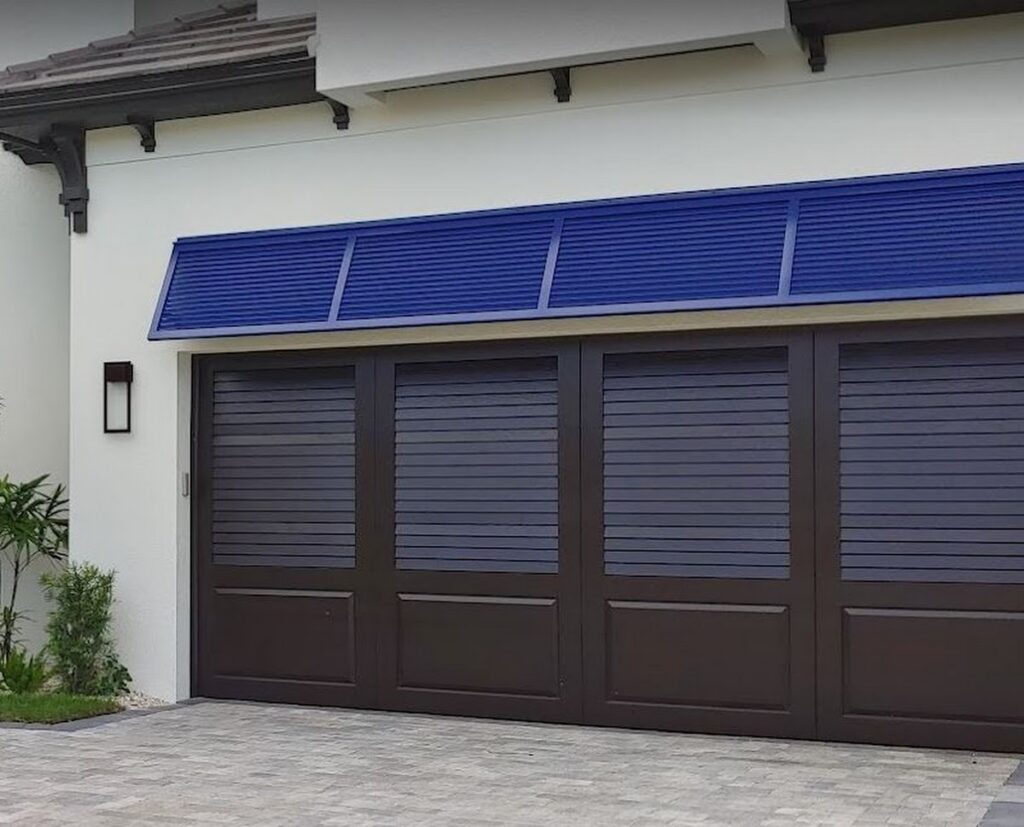8 Tips To to Maintain a Garage Door
Maintaining your garage door is essential to ensure its durability, functionality, and safety.. By staying on top of regular maintenance and upkeep, not only can you extend its lifespan, but you also sidestep hefty repair bills or the need for early replacements.
Let’s dive into this comprehensive guide for maintaining your garage door:
1. Visual Inspection of the overall door
Start with a close eye check. A simple look can often spot early issues before they turn into costly problems.
By regularly examining the visible parts of the door potential issues can be identified and addressed before they escalate into more significant problems down the road.
Here’s a detailed breakdown of what to look for during a visual inspection:
Door Panels
- Surface Damage: Look for cracks, dents, holes, or warping on the panels. Over time, due to wear and tear or accidents, panels may get damaged and may need repair or replacement.
- Alignment: Ensure that the panels are flush and aligned correctly. Misaligned panels can strain the garage door mechanism and hinder smooth operation.
- Rusty Patches: Particularly on metal doors, check for rust spots. These can compromise the door’s structural integrity and appearance.
Hinges
- Wear and Tear: Over time, hinges can wear out, making the door operation noisy.
- Rust and Corrosion: Metal hinges can rust, which can compromise their functionality.
- Loose Screws: Ensure that the screws holding the hinges are tight and in good condition.
Rollers
- Material Check: Rollers can be made of steel or nylon. Regardless of the material, they should roll smoothly and have no chips or cracks. They should be inspected twice a year and replaced every 7 years or so, depending on usage. If they’re chipped, worn, or cracked, they should be replaced sooner.
- Track Alignment: Rollers should stay aligned within the track. If they’re slipping out, it could indicate a track alignment issue or a worn-out roller.
Tracks
- Obstructions: Ensure that there are no obstructions or debris in the tracks, which could hinder door movement.
- Alignment: Tracks should be parallel and vertically aligned with the wall. Misaligned tracks can cause operational issues and strain the door mechanism.
- Rust and Damage: Look for signs of rust or physical damage. Bent or rusted tracks should be repaired or replaced.
Springs
- Tension: Garage door springs should be tightly coiled. Loose springs may indicate wear or lack of tension.
- Rust and Wear: Examine for rust and any signs of wear or stretching.
- Breaks: Springs should be continuous, with no gaps. A break in the spring is a clear sign that it needs replacement. Note: If you suspect an issue with springs, it’s advisable to call a professional due to the high tension they’re under.
Cables
- Fraying: Garage door cables are under high tension. Check for signs of fraying, wear, or damage.
- Attachment Points: Ensure cables are securely attached at both ends.
Weatherstripping and Seal
- Condition: Check the rubber seal at the bottom of the door. It should be flexible and free of cracks or tears.
- Fit: The seal should fit snugly against the ground to prevent drafts and pests.
Windows (if applicable)
- Cracks or Breaks: Examine any windows on the garage door for cracks, breaks, or gaps in sealing.
Hardware
- General Examination: Look over all nuts, bolts, and screws to ensure they are tight and not corroded.
Safety Tip:
Remember, it’s one thing to observe, another to intervene. Especially with parts under tension, like springs and cords, always opt for professional help if something seems off. Professionals don’t just fix the immediate problem; they can also suggest preventive measures or maintenance routines to extend the lifespan of the garage door system.
2. Cleaning and Lubricating your garage
Cleaning and lubrication are important components of garage door maintenance.
Proper cleaning helps prevent corrosion and build-up of dirt and debris, while regular lubrication ensures that the moving parts function smoothly, reducing wear and tear.
Let’s take a look at the process:
Cleaning Door Panels
Use a mild detergent mixed with water and a soft cloth or sponge to gently scrub the door panels, removing dirt, grime, and other build-up.
For wooden doors, avoid using harsh chemicals which might damage the wood finish.
For metal doors, check for rust spots.
If found, these can be gently cleaned with a suitable rust remover before repainting or sealing.
Windows (if present)
Use a window or glass cleaner to wipe down the windows on the garage door.
This helps in maintaining clarity and enhances the door’s appearance.
Tracks
Clear any debris or dirt accumulation in the tracks. This can be done using a cloth or a small brush.
Avoid using lubricant or grease on the tracks, as this can attract more dirt and grime.
Instead, ensure they remain clean and free of obstructions.
Weatherstripping
Clean the rubber seal at the bottom of the door using a water-detergent solution. This helps maintain its elasticity.
Rinsing
After cleaning, rinse the door and its components with clean water to remove any soap residue.
Allow it to dry completely before applying lubricant.
Lubrication
Types of Lubricants
It’s essential to use the right kind of lubricant.
White lithium grease or a silicone-based lubricant is ideal for garage doors. These types resist dirt and grime build-up, ensuring smooth operation over time.
Avoid using standard WD-40, as it’s more of a cleaner than a lubricant and can attract dirt.
- Rollers and Hinges
Apply the lubricant sparingly to the rollers and hinges, ensuring they move freely without any obstructions.
For metal rollers, focus on the bearings and avoid getting lubricant on the wheel itself. Nylon rollers usually have metal bearings, which should be the focus of lubrication.
- Springs
Springs can benefit from lubrication as it helps reduce the friction between coils.
Spray a little lubricant across the top of the springs, allowing it to penetrate the coils.
This can also help in preventing rust.
- Cables
While the cables themselves don’t need lubrication, the pulleys or sheaves where they run can benefit from it.
Apply a small amount of lubricant where the cable runs over the pulley.
- Lock and Arm Bar
If your garage door has a manual lock, a bit of lubricant can keep its mechanism smooth. Similarly, the arm bar, which connects the door to the opener, can be lightly lubricated.
Avoid Over-lubricating
Excess lubricant can attract dust and grime, so it’s essential to use just enough to coat the moving parts.
Wipe away any excess lubricant with a clean cloth.
Frequency
For optimal performance, our advice is to lubricate the moving parts of a garage door twice a year, preferably before winter and summer, as temperature fluctuations can affect lubricant performance.
In a nutshell, regular cleaning and lubrication can extend the life of your garage door components, reduce noise during operation, and ensure that the door functions smoothly and safely.
Always remember to wear safety gloves and glasses when performing these tasks, and ensure the garage door is disconnected from the opener for added safety.
3. Check the Door Balance
Disconnect the automatic opener (if you have one) by pulling the handle.
Lift the door manually to about halfway. If it stays in place, it’s balanced. If it falls or rises on its own, it might be off-balance, which can strain the opener. Call a professional to adjust it.
4. Inspect the Auto-reverse Feature
The auto-reverse feature is a crucial safety component of modern garage door openers.
It’s designed to prevent the door from closing when there’s an obstruction in its path, reducing the risk of injury or damage to objects.
Regularly testing and ensuring this feature is working correctly is vital.
How Does Auto-reverse Feature Work?
Garage doors typically have two mechanisms for the auto-reverse:
- Mechanical: This involves physical resistance. If the door encounters a physical object while closing, it should automatically reverse direction.
- Photoelectric (or Infrared): This uses sensors (also known as “photo eyes”) located on either side of the garage door about 6 inches above the floor. These sensors send a beam across the doorway. If this beam is broken while the door is closing, the door should automatically reverse.
How to Inspect the Auto-reverse Feature
Mechanical Test
Place a solid object, like a brick or a piece of wood, in the path of the door.
Activate the garage door to close.
When the door comes into contact with the object, it should immediately reverse direction. If it doesn’t, there may be an issue with the mechanical auto-reverse system.
Photoelectric Test
Start with the door fully open.
Activate the garage door to close.
As the door is closing, wave a broomstick, your foot, or any other long object in front of the photo eyes to break the infrared beam.
The door should reverse its direction immediately upon the beam being broken. If it doesn’t, the photoelectric system may be misaligned or malfunctioning.
Additional Tips:
- Sensor Alignment: If the door doesn’t reverse during the photoelectric test, the sensors might be misaligned. Check to see if they’re facing each other directly. Sometimes, they can get bumped or moved, causing misalignment. There are often indicator lights on the sensors that will blink if they’re not aligned properly.
- Clean the Photo Eyes: Dirt, spider webs, or other debris can obstruct the sensors. Gently clean them with a soft cloth and mild cleaner, then re-test.
- Sensitivity Settings: Garage door openers typically have sensitivity settings that determine the level of resistance needed to trigger a reversal. Over time, these might need adjustments. Consult the owner’s manual for guidance on how to adjust these settings. If you’re unsure or uncomfortable making these adjustments, it’s wise to consult a professional.
- Regular Testing: It’s recommended to test the auto-reverse feature monthly. Regular testing ensures that the safety mechanism will work when it’s needed most.
- Check for Updates: Garage door technology continues to advance. If your opener is very old, consider checking if there have been safety upgrades or recalls.
Safety First
The auto-reverse feature is a critical safety component, and ensuring its proper function can prevent accidents, injuries, and damage.
If at any point you believe there’s an issue with this feature or any other aspect of your garage door system, consult with a professional technician. They can provide guidance, make adjustments, and ensure that your door is operating safely and efficiently.
5. Tighten Loose Components
Over time, the motion of the door can cause hardware to loosen.
Tighten any loose bolts or screws you find on the door panels, tracks, and brackets.
6. Test the Door Opener’s Batteries
Replace the backup battery of the garage door opener annually or whenever the door doesn’t operate during a power outage.
7. Repaint or Refinish
Depending on the material of your garage door (wood, steel, aluminum), you may need to repaint or refinish it periodically to keep it protected from the elements and looking its best.
8. Safety Precautions
Always turn off the power to the garage door opener before working on it. If you’re ever uncertain about a maintenance task, or if it involves the springs or cables, it’s best to call a professional.
In Conclusion
By regularly checking and maintaining your garage door, you’ll ensure its smooth operation, safety, and longevity.
Remember, some tasks can be DIY, but others, especially those involving tension components like springs, should be left to professionals.


